CHC30113: Skills Workbook - Protecting Cultural Safety Activity
VerifiedAdded on 2021/02/19
|6
|1172
|251
Homework Assignment
AI Summary
This homework assignment requires the creation of a short activity focused on protecting cultural safety for young children aged 5 to 7. The activity involves writing a 200-300 word story featuring characters from different cultures, including Aboriginal or Torres Strait Islander heritage, with a positive message supporting inclusion and multiculturalism. The assignment also includes creating two visual aids representing scenes from the story, ensuring they align with the narrative and avoid negative stereotypes. Furthermore, the student must prepare five short discussion questions about the story, encouraging cultural diversity, promoting Aboriginal culture and linguistic diversity, and presenting hypothetical problems to stimulate critical thinking. The activity aims to foster understanding and appreciation for diverse cultures among young children. This submission is designed to be used in the unit Play and Development in the Skills Workbook.
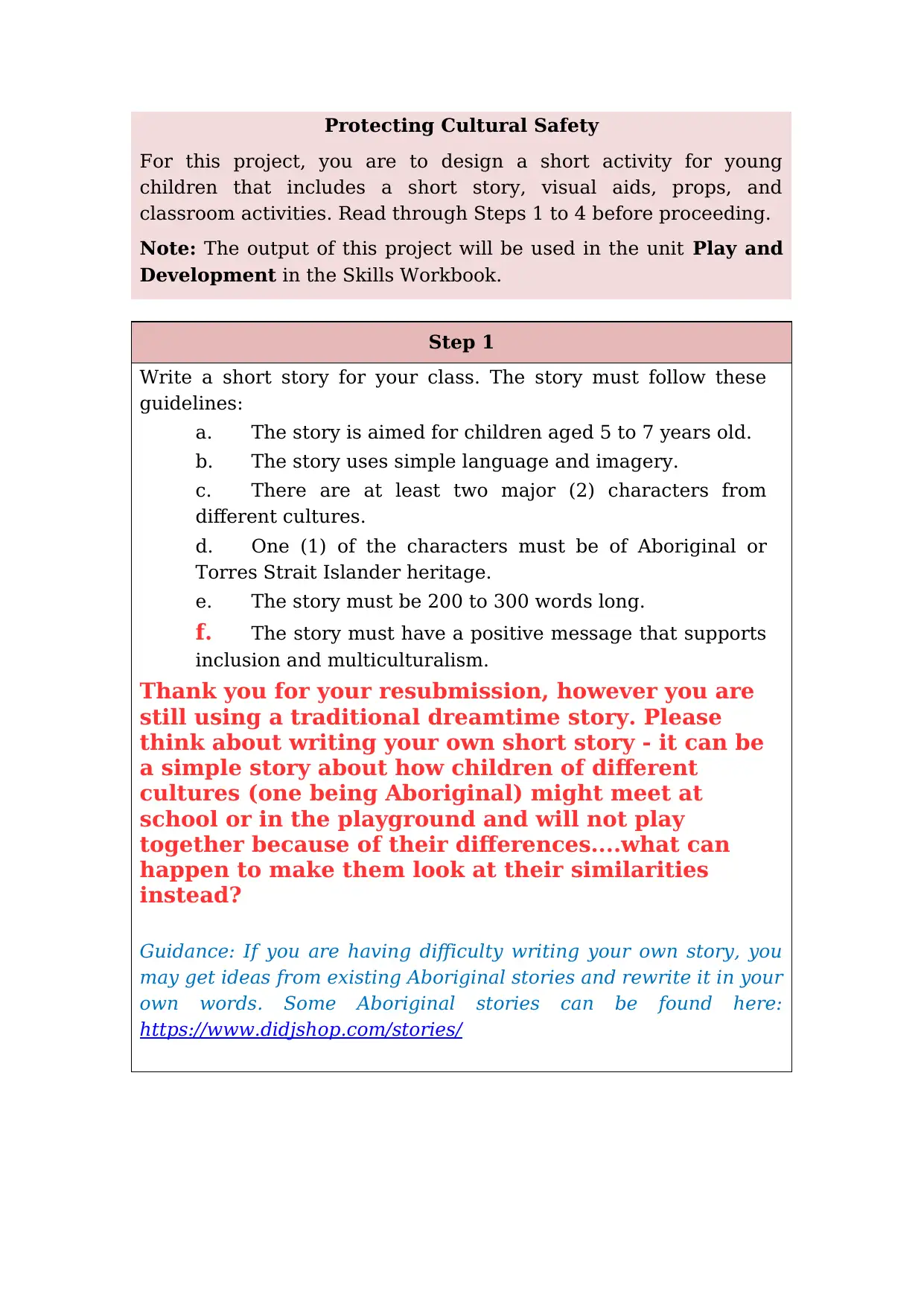
Protecting Cultural Safety
For this project, you are to design a short activity for young
children that includes a short story, visual aids, props, and
classroom activities. Read through Steps 1 to 4 before proceeding.
Note: The output of this project will be used in the unit Play and
Development in the Skills Workbook.
Step 1
Write a short story for your class. The story must follow these
guidelines:
a. The story is aimed for children aged 5 to 7 years old.
b. The story uses simple language and imagery.
c. There are at least two major (2) characters from
different cultures.
d. One (1) of the characters must be of Aboriginal or
Torres Strait Islander heritage.
e. The story must be 200 to 300 words long.
f. The story must have a positive message that supports
inclusion and multiculturalism.
Thank you for your resubmission, however you are
still using a traditional dreamtime story. Please
think about writing your own short story - it can be
a simple story about how children of different
cultures (one being Aboriginal) might meet at
school or in the playground and will not play
together because of their differences....what can
happen to make them look at their similarities
instead?
Guidance: If you are having difficulty writing your own story, you
may get ideas from existing Aboriginal stories and rewrite it in your
own words. Some Aboriginal stories can be found here:
https://www.didjshop.com/stories/
For this project, you are to design a short activity for young
children that includes a short story, visual aids, props, and
classroom activities. Read through Steps 1 to 4 before proceeding.
Note: The output of this project will be used in the unit Play and
Development in the Skills Workbook.
Step 1
Write a short story for your class. The story must follow these
guidelines:
a. The story is aimed for children aged 5 to 7 years old.
b. The story uses simple language and imagery.
c. There are at least two major (2) characters from
different cultures.
d. One (1) of the characters must be of Aboriginal or
Torres Strait Islander heritage.
e. The story must be 200 to 300 words long.
f. The story must have a positive message that supports
inclusion and multiculturalism.
Thank you for your resubmission, however you are
still using a traditional dreamtime story. Please
think about writing your own short story - it can be
a simple story about how children of different
cultures (one being Aboriginal) might meet at
school or in the playground and will not play
together because of their differences....what can
happen to make them look at their similarities
instead?
Guidance: If you are having difficulty writing your own story, you
may get ideas from existing Aboriginal stories and rewrite it in your
own words. Some Aboriginal stories can be found here:
https://www.didjshop.com/stories/
Paraphrase This Document
Need a fresh take? Get an instant paraphrase of this document with our AI Paraphraser
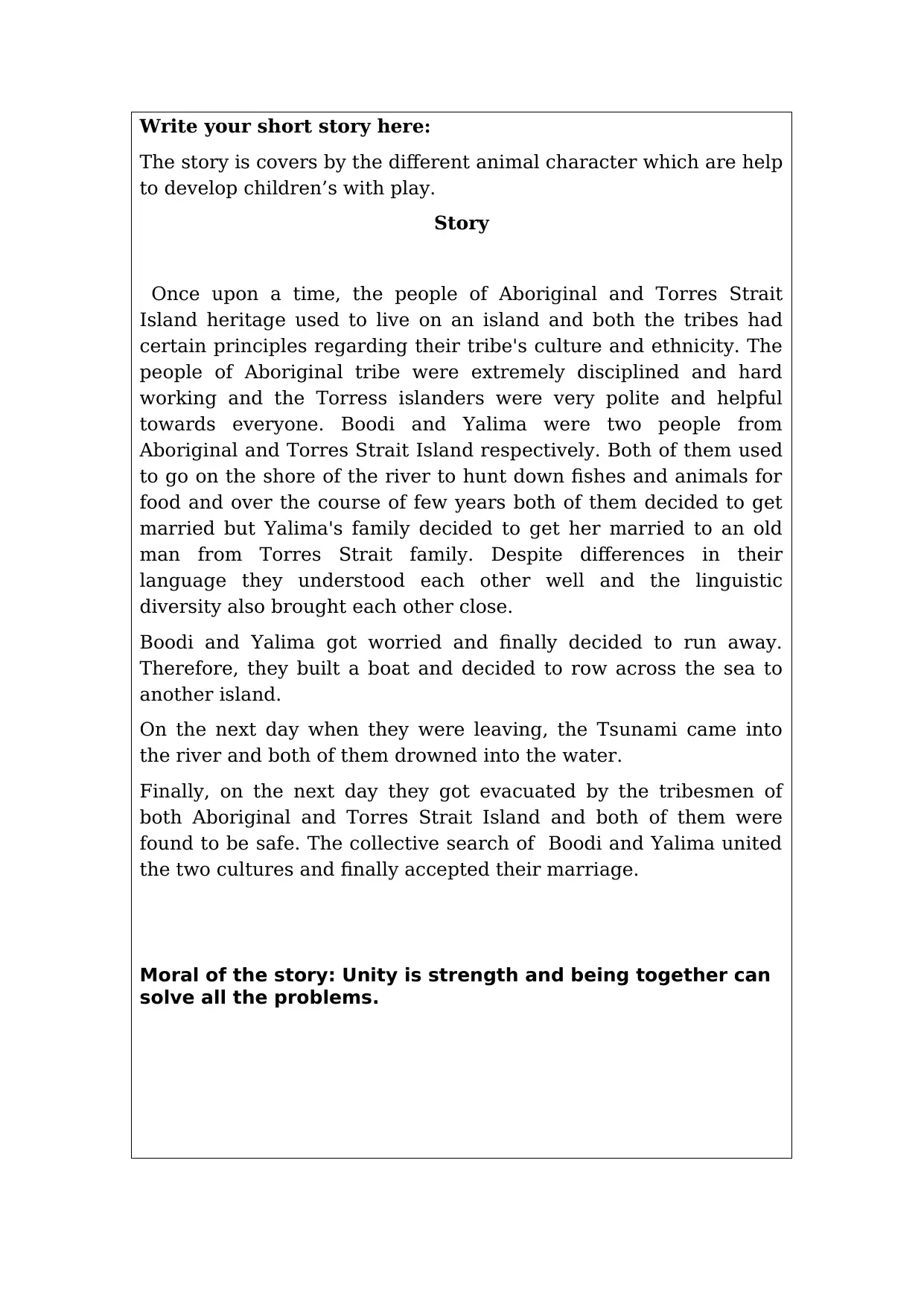
Write your short story here:
The story is covers by the different animal character which are help
to develop children’s with play.
Story
Once upon a time, the people of Aboriginal and Torres Strait
Island heritage used to live on an island and both the tribes had
certain principles regarding their tribe's culture and ethnicity. The
people of Aboriginal tribe were extremely disciplined and hard
working and the Torress islanders were very polite and helpful
towards everyone. Boodi and Yalima were two people from
Aboriginal and Torres Strait Island respectively. Both of them used
to go on the shore of the river to hunt down fishes and animals for
food and over the course of few years both of them decided to get
married but Yalima's family decided to get her married to an old
man from Torres Strait family. Despite differences in their
language they understood each other well and the linguistic
diversity also brought each other close.
Boodi and Yalima got worried and finally decided to run away.
Therefore, they built a boat and decided to row across the sea to
another island.
On the next day when they were leaving, the Tsunami came into
the river and both of them drowned into the water.
Finally, on the next day they got evacuated by the tribesmen of
both Aboriginal and Torres Strait Island and both of them were
found to be safe. The collective search of Boodi and Yalima united
the two cultures and finally accepted their marriage.
Moral of the story: Unity is strength and being together can
solve all the problems.
The story is covers by the different animal character which are help
to develop children’s with play.
Story
Once upon a time, the people of Aboriginal and Torres Strait
Island heritage used to live on an island and both the tribes had
certain principles regarding their tribe's culture and ethnicity. The
people of Aboriginal tribe were extremely disciplined and hard
working and the Torress islanders were very polite and helpful
towards everyone. Boodi and Yalima were two people from
Aboriginal and Torres Strait Island respectively. Both of them used
to go on the shore of the river to hunt down fishes and animals for
food and over the course of few years both of them decided to get
married but Yalima's family decided to get her married to an old
man from Torres Strait family. Despite differences in their
language they understood each other well and the linguistic
diversity also brought each other close.
Boodi and Yalima got worried and finally decided to run away.
Therefore, they built a boat and decided to row across the sea to
another island.
On the next day when they were leaving, the Tsunami came into
the river and both of them drowned into the water.
Finally, on the next day they got evacuated by the tribesmen of
both Aboriginal and Torres Strait Island and both of them were
found to be safe. The collective search of Boodi and Yalima united
the two cultures and finally accepted their marriage.
Moral of the story: Unity is strength and being together can
solve all the problems.
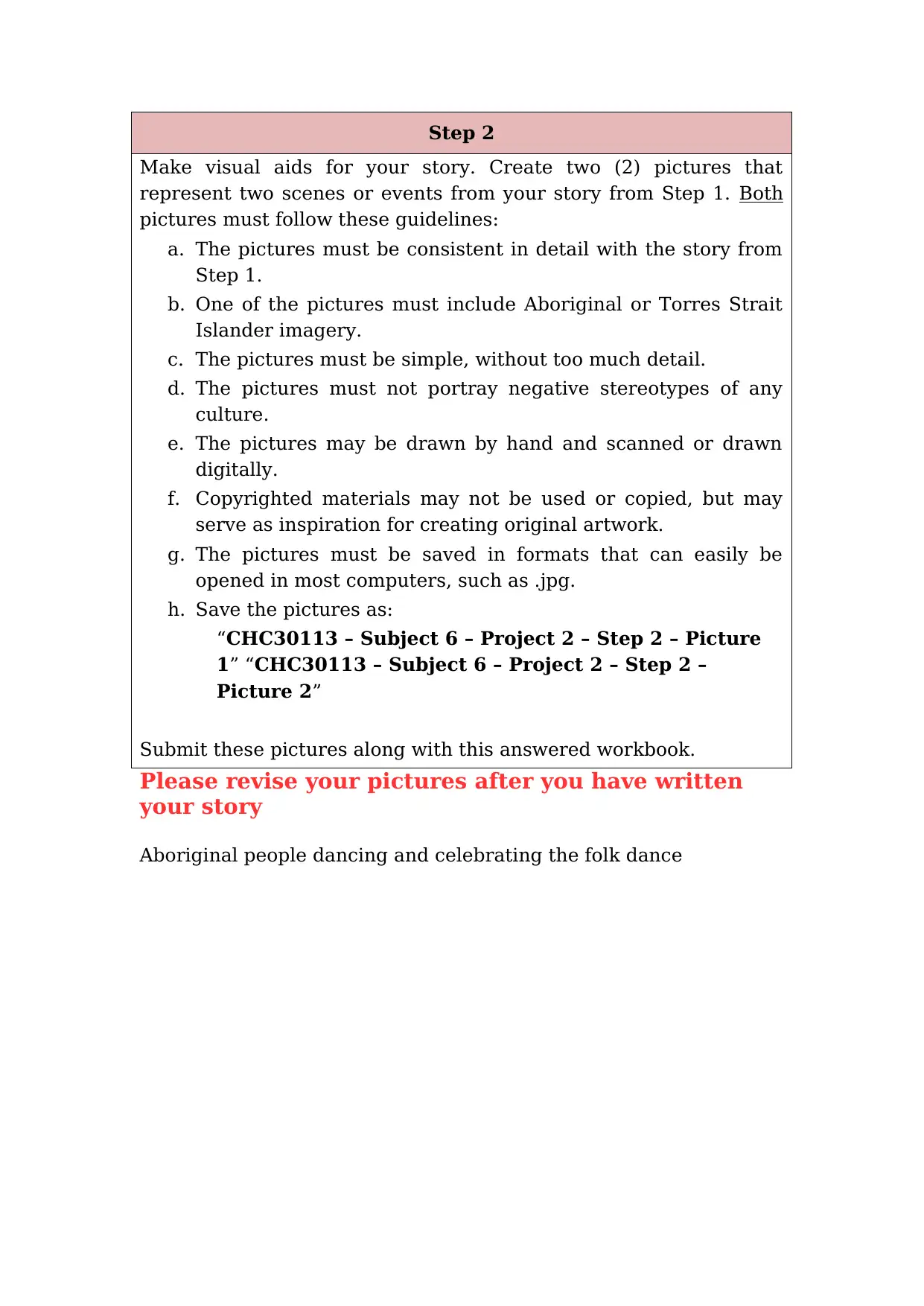
Step 2
Make visual aids for your story. Create two (2) pictures that
represent two scenes or events from your story from Step 1. Both
pictures must follow these guidelines:
a. The pictures must be consistent in detail with the story from
Step 1.
b. One of the pictures must include Aboriginal or Torres Strait
Islander imagery.
c. The pictures must be simple, without too much detail.
d. The pictures must not portray negative stereotypes of any
culture.
e. The pictures may be drawn by hand and scanned or drawn
digitally.
f. Copyrighted materials may not be used or copied, but may
serve as inspiration for creating original artwork.
g. The pictures must be saved in formats that can easily be
opened in most computers, such as .jpg.
h. Save the pictures as:
“CHC30113 – Subject 6 – Project 2 – Step 2 – Picture
1” “CHC30113 – Subject 6 – Project 2 – Step 2 –
Picture 2”
Submit these pictures along with this answered workbook.
Please revise your pictures after you have written
your story
Aboriginal people dancing and celebrating the folk dance
Make visual aids for your story. Create two (2) pictures that
represent two scenes or events from your story from Step 1. Both
pictures must follow these guidelines:
a. The pictures must be consistent in detail with the story from
Step 1.
b. One of the pictures must include Aboriginal or Torres Strait
Islander imagery.
c. The pictures must be simple, without too much detail.
d. The pictures must not portray negative stereotypes of any
culture.
e. The pictures may be drawn by hand and scanned or drawn
digitally.
f. Copyrighted materials may not be used or copied, but may
serve as inspiration for creating original artwork.
g. The pictures must be saved in formats that can easily be
opened in most computers, such as .jpg.
h. Save the pictures as:
“CHC30113 – Subject 6 – Project 2 – Step 2 – Picture
1” “CHC30113 – Subject 6 – Project 2 – Step 2 –
Picture 2”
Submit these pictures along with this answered workbook.
Please revise your pictures after you have written
your story
Aboriginal people dancing and celebrating the folk dance
⊘ This is a preview!⊘
Do you want full access?
Subscribe today to unlock all pages.

Trusted by 1+ million students worldwide

Paraphrase This Document
Need a fresh take? Get an instant paraphrase of this document with our AI Paraphraser
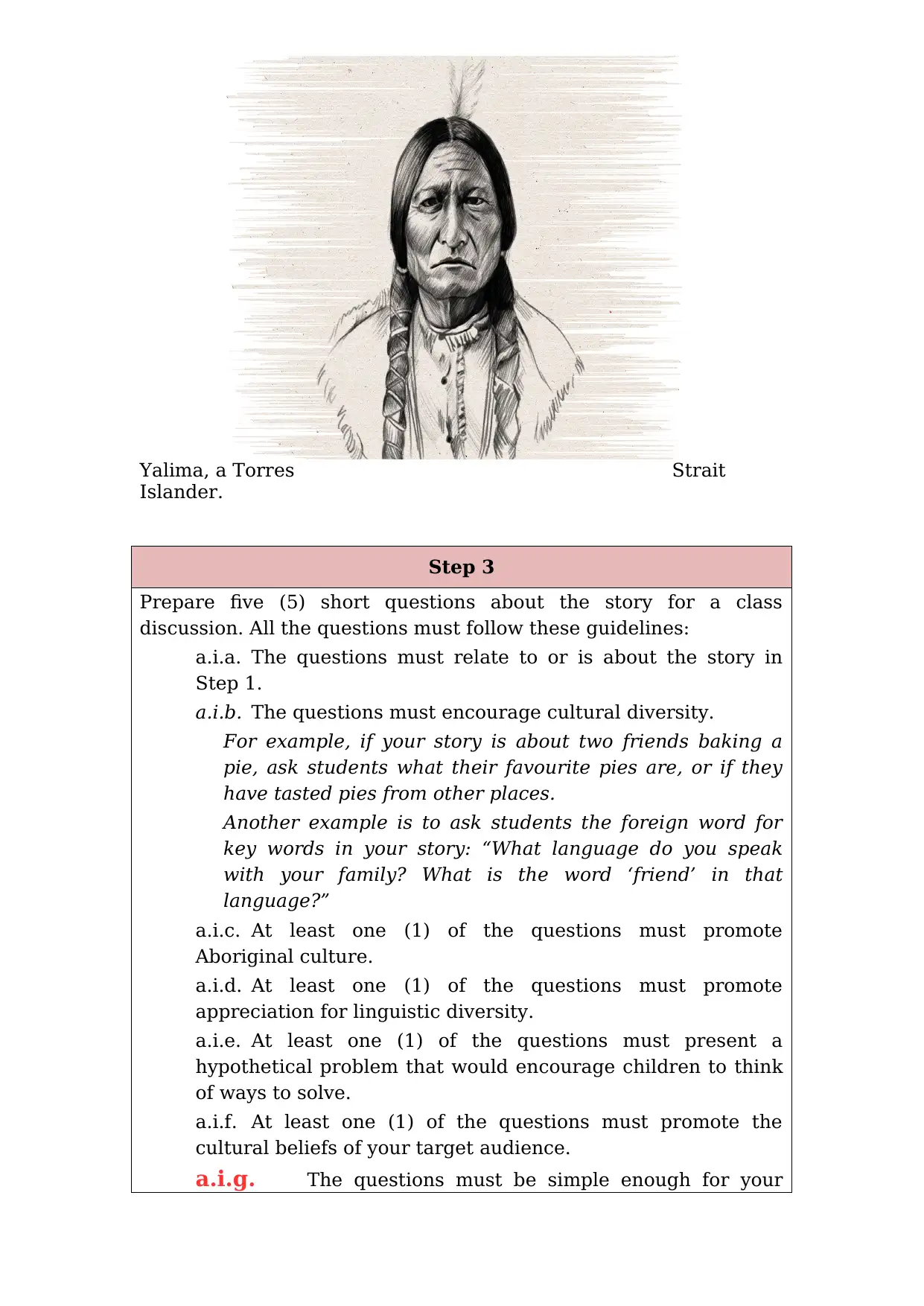
Yalima, a Torres Strait
Islander.
Step 3
Prepare five (5) short questions about the story for a class
discussion. All the questions must follow these guidelines:
a.i.a. The questions must relate to or is about the story in
Step 1.
a.i.b. The questions must encourage cultural diversity.
For example, if your story is about two friends baking a
pie, ask students what their favourite pies are, or if they
have tasted pies from other places.
Another example is to ask students the foreign word for
key words in your story: “What language do you speak
with your family? What is the word ‘friend’ in that
language?”
a.i.c. At least one (1) of the questions must promote
Aboriginal culture.
a.i.d. At least one (1) of the questions must promote
appreciation for linguistic diversity.
a.i.e. At least one (1) of the questions must present a
hypothetical problem that would encourage children to think
of ways to solve.
a.i.f. At least one (1) of the questions must promote the
cultural beliefs of your target audience.
a.i.g. The questions must be simple enough for your
Islander.
Step 3
Prepare five (5) short questions about the story for a class
discussion. All the questions must follow these guidelines:
a.i.a. The questions must relate to or is about the story in
Step 1.
a.i.b. The questions must encourage cultural diversity.
For example, if your story is about two friends baking a
pie, ask students what their favourite pies are, or if they
have tasted pies from other places.
Another example is to ask students the foreign word for
key words in your story: “What language do you speak
with your family? What is the word ‘friend’ in that
language?”
a.i.c. At least one (1) of the questions must promote
Aboriginal culture.
a.i.d. At least one (1) of the questions must promote
appreciation for linguistic diversity.
a.i.e. At least one (1) of the questions must present a
hypothetical problem that would encourage children to think
of ways to solve.
a.i.f. At least one (1) of the questions must promote the
cultural beliefs of your target audience.
a.i.g. The questions must be simple enough for your
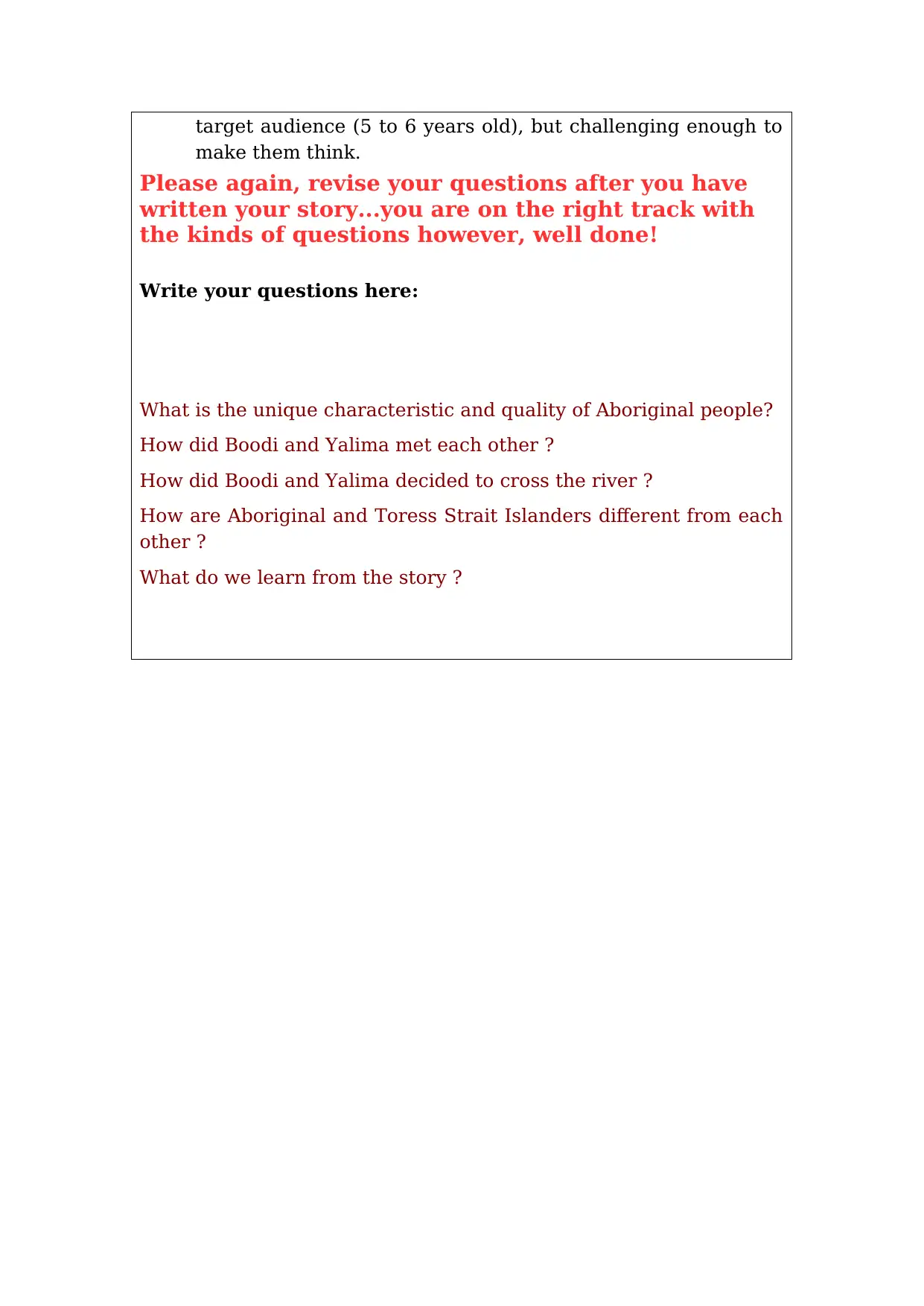
target audience (5 to 6 years old), but challenging enough to
make them think.
Please again, revise your questions after you have
written your story...you are on the right track with
the kinds of questions however, well done!
Write your questions here:
What is the unique characteristic and quality of Aboriginal people?
How did Boodi and Yalima met each other ?
How did Boodi and Yalima decided to cross the river ?
How are Aboriginal and Toress Strait Islanders different from each
other ?
What do we learn from the story ?
make them think.
Please again, revise your questions after you have
written your story...you are on the right track with
the kinds of questions however, well done!
Write your questions here:
What is the unique characteristic and quality of Aboriginal people?
How did Boodi and Yalima met each other ?
How did Boodi and Yalima decided to cross the river ?
How are Aboriginal and Toress Strait Islanders different from each
other ?
What do we learn from the story ?
⊘ This is a preview!⊘
Do you want full access?
Subscribe today to unlock all pages.

Trusted by 1+ million students worldwide
1 out of 6
Related Documents
Your All-in-One AI-Powered Toolkit for Academic Success.
+13062052269
info@desklib.com
Available 24*7 on WhatsApp / Email
![[object Object]](/_next/static/media/star-bottom.7253800d.svg)
Unlock your academic potential
Copyright © 2020–2025 A2Z Services. All Rights Reserved. Developed and managed by ZUCOL.



